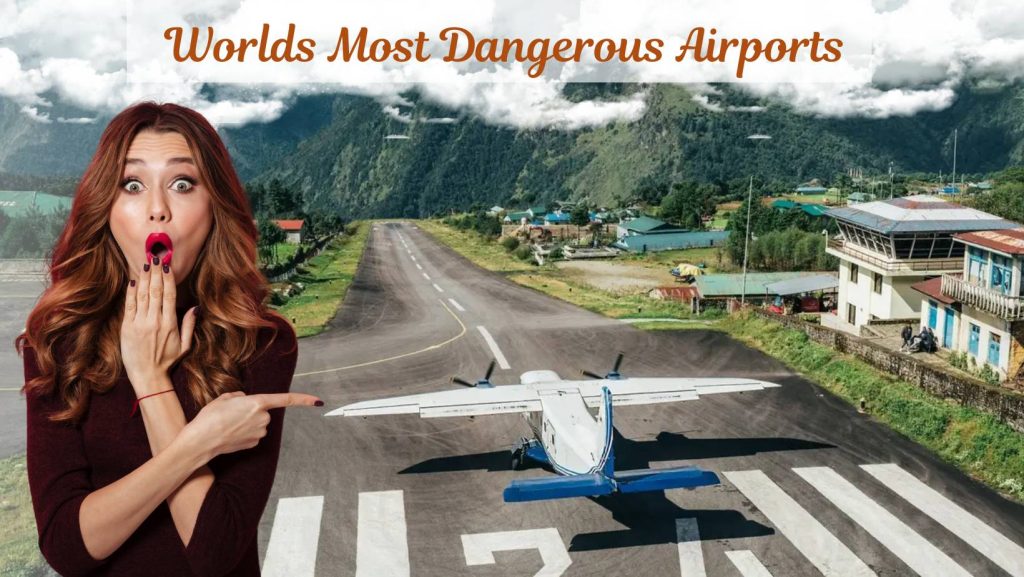When we think of air travel, the first word that comes to mind is usually “safety.” Aviation is one of the most regulated and secure industries in the world. Yet, despite strict protocols, there are airports around the globe that challenge even the most skilled pilots.
These airports, known as some of the world’s most dangerous airports, are often located in breathtaking but risky terrains, surrounded by mountains, oceans, or dense urban areas. They feature short runways, unpredictable weather, and unique landing approaches that leave travelers gripping their seats.
For aviation enthusiasts, thrill-seekers, or simply curious tourists, visiting the top 30 world’s most dangerous airports is both a frightening and fascinating experience.
What Makes an Airport Dangerous?
Not all airports are created equal. Some airports become famous not because of their size or luxury, but because of the extreme conditions they operate under. Here are the main factors that contribute to making them dangerous:
- Geography and Location Challenges: Many airports are built in high-altitude mountain ranges, on narrow islands, or close to cliffs and oceans, leaving little margin for error.
- Weather and Climate Conditions: Sudden fog, crosswinds, or heavy snowstorms often make landings risky. Airports in the Himalayas, Alaska, and other remote locations are known for rapidly changing weather.
- Short or Unusual Runways: Some runways are so short that pilots must land with extreme precision. In places like Lukla in Nepal, the runway even ends at a cliff, leaving no space for mistakes.
- High Traffic and Limited Safety Infrastructure: Older airports in busy cities may lack modern equipment or have limited space, making them difficult to manage during peak hours.
Top 30 World’s Most Dangerous Airports
Below is a detailed list of the world’s most dangerous airports that continue to attract both professional pilots and curious travelers. Each airport presents unique challenges, from extreme altitudes to tricky weather and unusually short runways.
1. Lukla Airport, Nepal (Tenzing-Hillary Airport)
- Location: Lukla, Solukhumbu District, Nepal
- Coordinates: 27.6869° N, 86.7295° E
Nestled at 9,500 feet in the Himalayas, Lukla serves as the main gateway to Mount Everest. Its extremely short 1,729-foot runway ends abruptly at a cliff, leaving no room for error. High winds, fog, and low oxygen levels make this airport one of the most dangerous globally, demanding highly skilled pilots.
2. Courchevel Altiport, France
- Location: Courchevel, Savoie, French Alps, France
- Coordinates: 45.4142° N, 6.6347° E
Located in the French Alps at a ski resort, this airport’s runway is only 1,762 feet long and has a steep gradient. Pilots must land uphill and take off downhill, often while navigating snow-covered slopes and sudden mountain winds. Only experienced alpine pilots operate here.
3. Princess Juliana International Airport, St. Maarten
- Location: Sint Maarten, Caribbean
- Coordinates: 18.0425° N, 63.1086° W
Famous for its approach over Maho Beach, pilots fly dangerously low over sunbathing tourists before touching down. The runway is relatively short, and strong crosswinds from the Caribbean Sea make landings tricky and spectacular.
4. Toncontin International Airport, Honduras
- Location: Tegucigalpa, Honduras
- Coordinates: 14.0608° N, 87.2172° W
Situated in a valley surrounded by mountains, Toncontin is notorious for its sharp turns during landing. The 6,112-foot runway requires extreme precision, and unpredictable weather adds to the challenge, making it one of Central America’s most perilous airports.
5. Madeira Airport, Portugal
- Location: Santa Cruz, Madeira, Portugal
- Coordinates: 32.6976° N, 16.7745° W
Built partly over the Atlantic Ocean with a runway extended on columns, Madeira Airport demands precision landings. Crosswinds, turbulence from surrounding mountains, and rapid weather changes make it challenging even for veteran pilots.
6. Paro Airport, Bhutan
- Location: Paro, Bhutan
- Coordinates: 27.4039° N, 89.4244° E
Located at 7,300 feet in the Himalayas, Paro Airport is one of the most difficult airports to operate. Pilots must navigate through deep valleys and mountain peaks, and only a handful of pilots worldwide are certified to land here.
7. Kai Tak Airport (Closed), Hong Kong
- Location: Kowloon, Hong Kong
- Coordinates: 22.3080° N, 114.2250° E
Though no longer operational, Kai Tak was legendary for its thrilling approach over densely packed skyscrapers. Pilots executed a dramatic “checkerboard” visual approach, making it an iconic symbol of aviation risk.
8. Gibraltar International Airport, Gibraltar
- Location: Gibraltar
- Coordinates: 36.1512° N, 5.3498° W
The runway intersects the main road into town, which must be closed for aircraft operations. Strong crosswinds from the surrounding mountains and the sea make landing and takeoff highly challenging.
9. Congonhas Airport, Brazil
- Location: São Paulo, Brazil
- Coordinates: 23.6261° S, 46.6561° W
Situated in downtown São Paulo, Congonhas has short runways and is surrounded by urban development. Heavy air traffic and unpredictable weather have historically led to several accidents, highlighting its risks.
10. Agatti Airport, India
- Location: Agatti Island, Lakshadweep, India
- Coordinates: 10.8500° N, 72.1833° E
Located on a narrow strip in the Lakshadweep Islands, Agatti’s runway has water on both sides. Sudden gusts, high tides, and limited runway length demand extreme precision during takeoff and landing.
11. Svalbard Airport, Norway
- Location: Longyearbyen, Svalbard, Norway
- Coordinates: 78.2462° N, 15.4653° E
Located near the Arctic Circle, Svalbard Airport faces extreme weather, including icy runways, polar nights, and snowstorms. Pilots must contend with low visibility and freezing temperatures regularly.
12. McMurdo Station Ice Runway, Antarctica
- Location: Ross Sea, Antarctica
- Coordinates: 77.8419° S, 166.6863° E
This seasonal ice runway shifts and cracks with temperature changes. Pilots face extreme cold, isolation, and unpredictable ice conditions, making each landing a high-risk operation.
13. Wellington Airport, New Zealand
- Location: Wellington, New Zealand
- Coordinates: 41.3272° S, 174.8053° E
Known as the “Windy Wellington,” this airport deals with strong crosswinds funneled by surrounding hills. Pilots must execute precise maneuvers to land safely on its short runways.
14. Aspen-Pitkin County Airport, USA
- Location: Aspen, Colorado, USA
- Coordinates: 39.2232° N, 106.8690° W
Nestled in the Rocky Mountains, Aspen Airport’s high altitude and narrow valley approaches make it difficult for pilots, especially during winter snowstorms. Sudden gusts and rapidly changing weather conditions add to the challenge.
15. Narsarsuaq Airport, Greenland
- Location: Narsarsuaq, Kujalleq, Greenland
- Coordinates: 61.1606° N, 45.4258° W
Surrounded by fjords and glaciers, pilots must navigate icy winds and sudden storms. Limited navigation aids and isolated conditions require advanced training and experience.
16. LaGuardia Airport, USA
- Location: Queens, New York City, USA
- Coordinates: 40.7769° N, 73.8740° W
Serving New York City, LaGuardia has short runways and heavy air traffic. Its proximity to skyscrapers and frequent weather changes create a high-pressure environment for pilots.
17. Barra Airport, Scotland
- Location: Barra, Outer Hebrides, Scotland
- Coordinates: 56.9950° N, 7.4381° W
Unique as the only airport where scheduled flights land directly on a sandy beach. Tides, shifting sand, and weather conditions make landings unpredictable, requiring pilots to adapt constantly.
18. Telluride Regional Airport, USA
- Location: Telluride, Colorado, USA
- Coordinates: 37.9375° N, 107.9085° W
Situated on a plateau in Colorado, the runway is surrounded by steep drop-offs. Pilots must contend with mountainous terrain, high altitude, and sudden wind shifts during every approach.
19. Tioman Island Airport, Malaysia
- Location: Tioman Island, Pahang, Malaysia
- Coordinates: 2.7925° N, 104.1567° E
A short runway at the foot of mountains requires pilots to execute a sharp 90-degree turn before landing. Tropical storms and heavy rain increase landing difficulty.
20. Eagle County Airport, USA
- Location: Gypsum, Colorado, USA
- Coordinates: 39.6425° N, 106.9176° W
Popular with winter sports enthusiasts, Eagle County Airport’s high altitude and unpredictable mountain winds make landings tricky. Pilots must manage limited visibility during snowstorms.
21. Saint Barthélemy Airport (St. Barts)
- Location: Saint Barthélemy, Caribbean
- Coordinates: 17.9006° N, 62.8497° W
This Caribbean airport has a runway ending at a beach. Short length, ocean proximity, and wind turbulence create a thrilling but dangerous landing experience.
22. Mountain Airstrips in Papua New Guinea
- Location: Various remote locations, Papua New Guinea
- Coordinates: Approx. 6.3150° S, 143.9550° E
Numerous small airports with rugged, short, and uneven runways test pilots daily. Sudden tropical storms and high-altitude approaches add to the risk.
23. Chicago Midway Airport, USA
- Location: Chicago, Illinois, USA
- Coordinates: 41.7868° N, 87.7522° W
Surrounded by dense urban development, Midway has short runways and busy airspace. Pilots must carefully manage takeoffs and landings while avoiding city infrastructure.
24. Funchal Airport, Madeira (Revisited)
- Location: Santa Cruz, Madeira, Portugal
- Coordinates: 32.6976° N, 16.7745° W
Funchal’s runway is partially extended over the sea. Pilots face strong Atlantic winds and mountain turbulence, demanding precise timing and skill during approaches.
25. Saba Airport, Caribbean Netherlands
- Location: Saba, Caribbean Netherlands
- Coordinates: 17.6386° N, 63.2308° W
Home to the world’s shortest commercial runway at just 1,312 feet. Positioned between cliffs and the ocean, it requires pilots to execute extremely precise landings.
26. Qamdo Bamda Airport, Tibet
- Location: Qamdo, Tibet, China
- Coordinates: 30.4667° N, 97.2333° E
One of the world’s highest airports at 14,000 feet. Thin air affects engine performance and passenger oxygen levels, and the long runway is surrounded by mountains.
27. Juancho E. Yrausquin Airport, Saba
- Location: Saba, Caribbean Netherlands
- Coordinates: 17.6450° N, 63.2340° W
Famous for its dangerous location between cliffs and the ocean. Only small aircraft can safely land here, making it a challenging experience for even skilled pilots.
28. Kansai International Airport, Japan
- Location: Osaka Bay, Osaka, Japan
- Coordinates: 34.4342° N, 135.2442° E
Built on an artificial island, this airport faces typhoons, high tides, and subsidence risks. Engineers have designed complex systems, but pilots still need caution during landings.
29. Madeira Funchal Revisited, Portugal
- Location: Santa Cruz, Madeira, Portugal
- Coordinates: 32.6976° N, 16.7745° W
Notable for its combination of ocean columns and mountain winds. The airport requires constant attention from pilots to avoid turbulence and ensure safe landings.
30. Princess Juliana Airport Revisited, St. Maarten
- Location: Sint Maarten, Caribbean
- Coordinates: 18.0425° N, 63.1086° W
Its fame for low-altitude beach approaches and short runways makes it a major tourist attraction. Crosswinds, heavy aircraft traffic, and thrill-seekers below add to its legendary status.
Is It Safe to Travel Through These Airports?
Despite their reputation, most of these airports follow strict international aviation safety standards. The danger lies in environmental and geographical factors rather than negligence. Airlines often schedule flights only in favorable weather conditions, and pilots undergo rigorous training before being allowed to land.
Tips for Passengers Flying to or from Dangerous Airports
- Stay Informed: Check weather conditions before your trip.
- Trust the Crew: Pilots at these airports are specially trained.
- Book Smart: Choose seats near the wing for stability during turbulence.
- Stay Calm: Nervousness is natural, but remember thousands of flights land safely every year.
FAQs
1. What is the #1 most dangerous airport in the world?
Lukla Airport in Nepal is considered the most dangerous due to its short runway and high-altitude location.
2. Which dangerous airports are still open for tourists?
Airports like Lukla, Courchevel, Princess Juliana, and Paro are fully operational and receive tourist flights.
3. Are dangerous airports safe to land on?
Yes, despite challenges, safety measures and experienced pilots make these landings as safe as possible.
4. Why don’t governments close dangerous airports?
Most of these airports are essential lifelines for remote areas, making them impossible to shut down.
5. What’s the shortest dangerous runway in the world?
Saba Airport in the Caribbean has the shortest runway at just 1,312 feet.
6. Can regular airlines land at dangerous airports?
Only certain aircraft types are approved, depending on the airport.
7. How do pilots train for dangerous airports?
They undergo simulator training, special certifications, and supervised flights.
8. Which U.S. airports are considered dangerous?
LaGuardia, Midway, Aspen, Telluride, and Eagle County are often cited.
9. What are the most dangerous airports in Asia?
Lukla in Nepal, Paro in Bhutan, and Qamdo Bamda in Tibet are the top three.
10. Should travelers avoid flying into these airports?
Not necessarily. They are thrilling experiences, but nervous flyers may prefer alternatives.






